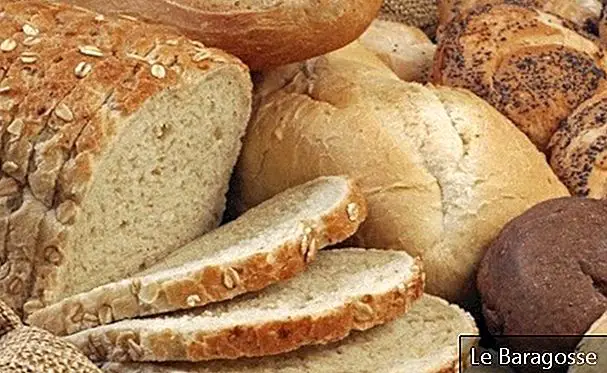
There is no denying it: bread is part of most people's diets. Many of them even confess to considering it irreplaceable for breakfast!
Nowadays, there is a huge variety of these products for sale in the market, besides, of course, the traditional bread made in bakeries. People who care more about healthy eating tend to choose the full versions; but others don't trade white bread for nothing ?!
But the fact is that not even the healthiest breads can be eaten in excess. Otherwise, they offer several health hazards.
And if you think the only risk of overeating is weight gain, you're wrong: bread can even lead to the development of diseases like diabetes.
Below is a list of some of the problems that eating bread can generate, as well as information on how to eat this food properly, without harming your health:
1. Consumption of white bread can lead to diabetes.
Paula Crook, nutritionist at PB nutrition consultancy, explains that white bread is basically made up of processed flour (simple carbohydrate) - which has a sugar-like action that can lead to insulin resistance and, in the future, diabetes.
2. White bread does not promote satiety and causes bloating
Still according to Paula Crook, white bread is low in nutrients and contains no fiber in its composition. That is, its consumption does not promote satiety. The yeast is also fattening and causes swelling ?, says.
"Therefore, it is recommended to always opt for whole grain bread, rich in fiber and, if possible, grain, which will bring satiety and balance the compulsion, without weight gain or damage to the body," says the nutritionist.
Paula stresses that whole grain bread has better nutritional quality than white bread, as it has unrefined flours. ? That is, this type of bread has more fibers that help promote greater satiety and not lead to peak blood glucose in the individual? that can have alarming long-term consequences, such as insulin resistance and overweight ?, explains.
Still according to the nutritionist, a fiber-rich brown bread can be considered a healthy food, yes, provided consumed in moderation.
3. Breads are high in carbohydrates and can lead to weight gain.
Paula Crook points out that any type of bread has carbohydrate-rich ingredients, either full-length, gluten-free or with white flour. Excessive carbohydrate consumption without an increase in energy expenditure is turned into fat. That is, the person will gain weight ?, explains.
Thus, it is noteworthy that not even whole grain breads should be consumed in excess.
4. Most breads have gluten
Gluten is a protein found in wheat, oats, rye and barley. Nutritionist Paula explains that for some people, the so-called celiac, ingestion of this protein is harmful to health, causing allergic reactions.
However, it is not only the celiac who benefits from not eating gluten-containing products. Research suggests that frequent intake of large amounts of protein by hypersensitive people affect some body functions, and may cause some symptoms such as constipation, rhinitis, asthma, arthritis, dermatitis, mood swings, anxiety and depression? "A large number of people note that symptoms are attenuated and even disappear with the removal of this allergenic food from the diet," he adds.
5. Many Breads Have Sugar
Few people know, but many breads have sugar in their composition, which of course can be harmful to health.
? Refined sugar has no nutritional value. Its consumption raises blood glucose rapidly, increasing insulin and, consequently, the fat deposition in the body. In addition, it is associated with increased inflammatory disease, intestinal microflora imbalance, increased proliferation of bacteria and fungi in the body ?, highlights nutritionist Paula Crook.
How to choose a good bread?

Knowing the harms that excessive consumption of bread can offer, the question arises: how to choose a? Good bread ??
Paula Crook points out that a good bread should not have white flour in its composition. This is presented on the food label as folic acid enriched wheat flour. Many so-called wholemeal breads feature much more white flour than wholemeal flour.It is important to note the first ingredients on the food label, as they are described in greater quantities than those in the product. That is, the first ingredients must be whole (oats, rye, whole wheat, flaxseed, etc.) ?, explains.
According to the nutritionist, in addition to whole grain breads, gluten free are also good options for a rotating consumption. Because the ideal is to vary the type of carbohydrate each day. The gluten problem is the daily consumption in several meals ?, he adds.
Adequate consumption
Paula Crook explains that the ideal is not to consume bread made with wheat flour every day, even if it is the whole type. "It's important to rotate with other types of healthy carbs," he says.
Nutritionist Paula cites below some examples of healthy bread substitutes:
- Oat flakes
- Quinua Flakes
- Amaranth Flakes
- Tapioca with chia seed in the dough
- Pancake made with quinoa or brown rice flour
- Sweet potato
- Yam, among others.
With all these tips, is it easier to follow a healthier diet and not overdoing bread? which, as has been shown, can pose many health hazards if consumed in excess.
Is Whole Wheat Bread Really Healthier Than White Bread? (April 2024)
- food
- 1,230
















